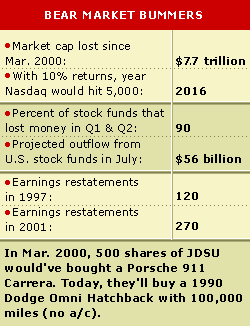NEW YORK (CNN/Money) -
Ten trading days, 1,360 points off the Dow. Let's start calling the "sell off" what it is. Let's call it a panic. Let's call it a crash.
Indeed, after rallying following Sept. 11, the markets topped out in March, and have been careening downward ever since: The Dow is down 25 percent since then; the S&P 500 is down 27 percent, and the Nasdaq is down 32 percent. And the continuation of selling on Monday, following the seventh worst point-loss in Dow history, is doing little to reassure investors that the worst is over.
People worry that, with $7.7 trillion knocked off U.S. market capitalization since March 2000 ($750 billion in the past week alone!), the selling will bleed into the economy, not just snuffing the recovery but sending the country into a deflationary episode like the one Japan labors under. Or like the United States strained under in the 1930s.
The fear breeds selling, the selling breeds more fear. Some economists have even begun to talk about how the Fed could step in and cut rates to try and stanch the bleeding -- while at the same time they worry that for the Fed to do that would only stoke the market's fears.
Remember 1998?
This script is starting to look familiar, says James Padinha, economic strategist at Arnhold & S. Bleichroeder. It's starting to feel like 1998, when fears ran high that financial crisis would seize up the economy. "It's just eerie," he said. "We have exactly the same kind of thing going on."
In the latter half of 1998 a debt crisis in Russia and hedge funds, which were almost as profoundly overleveraged as they were mispositioned, sparked a global flight to safety in the markets. It was a slow growing panic -- you would think it was going to get better and it just kept getting worse. As the market deteriorated investors began fearing not only that the United States would slip into recession, but that it would enter its first deflationary episode since the Great Depression. The Fed cut rates three times in an attempt to shore things up.

The fears never came true, of course. The hurt that got put on markets never turned up in the economy -- heck, economic growth actually accelerated through the entire episode. And now, even though all the indicators are pointing toward economic growth, people are starting to worry stocks could snuff the recovery.
"There's this alternative scenario where the financial crisis starts to bleed into the economy in a major way," said Lehman Brothers economist Ethan Harris. "It's a major risk and it should be given more play." Harris thinks the decline in stocks since March will trim 1.5 percentage points off growth in the economy -- a third off what the rate would have been. If the market keeps tanking, he thinks the Fed is going to have to cut rates.
Padinha, however, thinks the notion that the market could sink the economy is just wrong, an idea bred by Wall Street economists who are a little too close to stocks. Take a look at the economy, and it's clear that things are getting better. Sales and industrial production are gaining ground. Inventories, slashed to the bone, have begun to grow again.
"If it turns out all this economic data is wrong," said Padinha, "this is going to be the biggest misread in economic history."
The nightmare scenario
Padinha probably has it right, thinks Aeltus Investment Management strategist Jim Griffin. But he worries about the off chance that this really is going to be much worse than 1998 experience. There are differences.
| |
 Coping with the bear market
Coping with the bear market
| |
| | |
| | |
|
"In 1998 it was somebody else's problem, with their blood splashing on our trousers," he said. "This time we're ankle deep in our own blood." Unlike 1998, the current crisis is rooted in the United States. It's our stock market bubble that popped. The United States was attacked, and our CEOs cooked the books. In 1998, U.S. investors were staring out at the world and wondering where it would end. Now the world's investors are staring at the United States and wondering the same thing.
Griffin can imagine, he said, a Japanese-style pullback from risk in the United States, in which investors give up, banks refuse to lend and the economy languishes. He can imagine other countries, accustomed to the United States' role as the world's economic locomotive, not taking up the standard. He can imagine a crisis of capitalism of a 1930s order. Griffin thinks the people talking about deflation are probably wrong, but he doesn't think they're crazy.
We can be smug now, and say the 1987 crash, when the Dow dropped 30 percent in two days, was all about the way investors were using portfolio insurance. But at the time it seemed much bigger than that. At the time, people were seriously entertaining the idea of a depression.
We're not there quite yet, thinks Padinha, but we're on our way. He can see the panic growing, see the 1930s references getting progressively more ink. He can imagine the Fed cutting and people arguing that lower rates won't do a thing. That moment -- and who knows how far down from here it is -- will be the sign.
"Right there is the bottom," he said. "The bottom for the funds rate, the bottom for the market, the bottom for everything."

|

